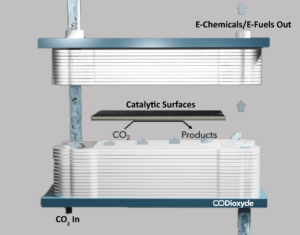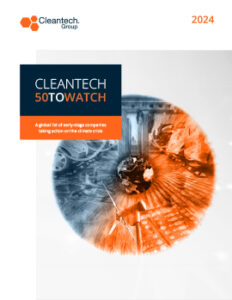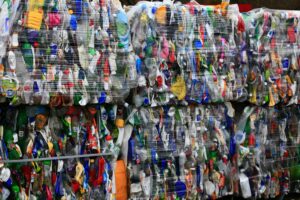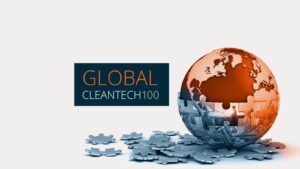Cleantech 50 to Watch Case Study: Dioxycle
Solution: Dioxycle is a developer of integrated modular electrolyzer systems to capture and convert industrial carbon dioxide emissions.
Nisa Mirza of Cleantech Group sat down with Dioxycle’s Sarah Lamaison, Co-Founder & CEO, to discuss all they’ve done to be recognized as a Cleantech 50 to Watch company.

Sarah Lamaison, Co-Founder & CEO, Dioxycle
Cleantech Group: Can you give us some context for the issue your technology is attempting to solve?
Sarah Lamaison: Every year, 35 gigatonnes of anthropogenic CO2 are released into the atmosphere, making it a major contributor to climate change. Action to reduce these emissions is critical if we want future generations to appreciate the beauty of the environment as we know it, and we have long been committed to this cause.
Dioxycle’s technological philosophy evolved directly from the example set by photosynthetic life, which demonstrated that low temperature, efficient conversion of carbon dioxide (CO2) to chemical fuels is critical to energy storage and release. Our innovations stem from the development of a customized electrolysis environment capable of converting carbon dioxide into energy-rich and valuable products with minimal energy input.
Cleantech Group: What sparked Dioxcycle in the first place?
Sarah Lamaison: For the past six years, we have been investigating electrolysis and CO2 conversion in some capacity. We had concentrated on designing electrocatalysts, in particular, and it was clear from our research that the technology was ready to enable us to take the leap from academia to start-up. Furthermore, we had previously had dialogues with industrial groups that expressed a need for CO2-converting technologies. It became evident that industrial sectors were looking for new ways to reduce their annual emissions, so we set out to find them a solution.
Cleantech Group: Where did the name Dioxycle come from?
Sarah Lamaison: Dioxycle is simply the words “carbon dioxide” and “recycle” together, pronounced “Diox-cycle.” In the end, we decided to just chose a name that makes it clear what we do: recycle carbon dioxide.
Cleantech Group: How is Dioxycle recycling carbon?
Sarah Lamaison: We are developing valuable chemicals and fuels from industrial CO2. CO2 is obviously a huge problem when it is emitted indefinitely into the atmosphere, but it also has a huge potential to be a source of sustainable feedstocks with an efficient CO2 conversion technology. As a result, Dioxycle is developing electrolyzer technologies to convert CO2 into energy-rich small molecules such as carbon monoxide, formic acid, ethylene, and ethanol. These are exceptionally versatile building blocks used in the production of a wide range of everyday substances such as polymers, commodity chemicals, and fuel.
We are designing our electrolyzer from the ground up in order to create the most energy-efficient CO2 electrolysis platform possible. Because energy efficiency is directly related to the cost of CO2 conversion, it is critical to an economically viable process. We are now scaling the electrolyzer to transform industrial volumes of CO2 at a reasonable cost. Our objective is to allow a polluting industry to capture and convert its emissions into valuable feedstock that can be used on-site or sold to another industry, thereby creating a circular CO2 economy.
Based on our core electrolyzer, our solution will be integrated in container-sized modular systems to allow for the controlled capture and treatment of industrial CO2-containing exhausts. The individual cells of the electrolyzer have the potential to transform >80 kg of CO2 per m² each day and through stacking these cells, a single container will be able to convert several tonnes of CO2 each day.

Cleantech Group: What have been some of the obstacles you’ve had to overcome since launching in 2021?
Sarah Lamaison: Due to the pandemic, we found that the supply chains for some equipment and materials were disrupted, which we had to account for, but teleconferencing and social distancing protocols in the lab allowed us to continue at the necessary pace. We were fortunate to have worked in labs at Stanford University prior to starting Dioxycle and at the beginning of the pandemic, which provided excellent examples of how to run an effective research lab while keeping everyone feeling comfortable and safe.
Cleantech Group: What is your calculus for the future of the industry?
Sarah Lamaison: A few start-ups are working on similar concepts, while others are investigating complementary processes to transform, separate, or store CO2. Working on CO2-related technology is an extremely exciting time. The good news for us is that there is plenty of CO2 for everyone right now, with only a few actors capitalizing on the market, though we recognize that having all this CO2 doesn’t give much cause to celebrate!
CO2 electrolysis offers a route to free us from crude oil dependence. For years, chemicals and fuels have been produced by refining crude oil, which when burned, eventually releases CO2. The more oil extracted, the more CO2 that accumulates in our atmosphere. Dioxycle provides the electrochemical blocks capable of converting CO2 back into useful feedstocks, called e-fuels and e-chemicals. Their vision is a new, cleaner world where CO2 feeds our society, instead of threatening our climate.
For more information, visit the Dioxycle website.



